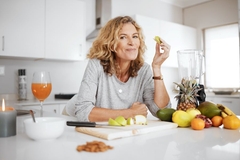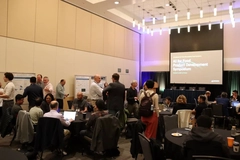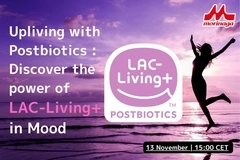Propelling probiotics: Potential impact of complex oligosaccharides on gut bacteria
08 Jul 2024 --- Amid a growing demand and market for biotics, researchers at the Food Science and Technology department at the University of California (UC) Davis, US, are investigating the chemical building blocks of oligosaccharides — carbohydrates from three to six units of simple sugars — and how they react with bacteria in the human gut microbiome. The building blocks of these compounds significantly impact which bacteria can feed off them.
Daniela Barile, a professor and chemist at UC Davis’ food science and technology, tells Nutrition Insight that increased diversity of the building blocks from a chemical point of view “results in increased prebiotic selectivity.”
“We want to increase beneficial bacteria and decrease pathogenic bacteria to eliminate the problem of dysbiosis, an imbalance that many people have and is associated with obesity, diabetes and many chronic diseases.”
She cautions that there is a lot of mistrust in probiotics. “This is because too many products on the market don’t alleviate the symptoms; they are only temporary and don’t persist. Why? Because you send them down and you give them nothing to eat. They’re starving. You need to give them their favorite food that only they can eat. Because there’s a lot of bacteria in the gut.”

“If you’re giving them a little crumb and everybody else is stealing it as soon as they go down, it will not work.”
Reviewing grape pomace
Barile explains that her lab recently published a review uncovering the promising role of grape pomace, a waste product of the wine industry.
Although the review found much information on the product’s promising value, none of the articles analyzed says which component is responsible.
“They’re observational,” she highlights, “saying people are doing better if the microbiome is more diverse, but what does it mean? When you want to design a product, which components will you try to target?”
Meanwhile, the UC Davis lab is researching oligosaccharides and phenolics and how they work together. Barile details that many of the benefits of grape marc have been attributed to phenolics, as researchers were not separating the phenolics from oligosaccharides.
 The chemical structures of oligosaccharides or “building blocks” impact which bacteria can use them.She explains that the stimulation and growth of Bifidobacteria and Lactobacilli could be attributed to oligosaccharides as they are an “excellent carbon source.” These molecules are derived from polysaccharides in the cell wall of the grape and are known to be prebiotic.
The chemical structures of oligosaccharides or “building blocks” impact which bacteria can use them.She explains that the stimulation and growth of Bifidobacteria and Lactobacilli could be attributed to oligosaccharides as they are an “excellent carbon source.” These molecules are derived from polysaccharides in the cell wall of the grape and are known to be prebiotic.
These molecules’ structures or “building blocks” impact which bacteria can use them. Bacteria contain genes that make enzymes break down oligosaccharides, building transporters “like private fingerprint elevator doors that only open for those building blocks.”
“Oligosaccharides can also act as a decoy for pathogen bacteria,” adds Barile. “Pathogens decide they want to eat them, as they’re sugars, so they bind to the sugars, but then they cannot open the elevator door and, therefore, cannot consume them. Eventually, they’re flushed away.”
Discovery at UC Davis
The discovery process is very labor intensive, emphasizes Barile. It involves separating the molecule of interest from phenolics, proteins, lipids and anything else in the sample. After that, the researchers conduct mass spectrometry to identify the chemical formula expressed in peaks.
“We found 40 unique oligosaccharides and a size — number of building blocks — of between three and eight, which is the same as if you were to draw a bell curve of human milk oligosaccharides, which is the gold standard. Most abundant oligosaccharides are between three and eight, and the larger ones are present in trace amounts.”
She explains that this “is a good size for these molecules to interact with the bacteria” to break down internally as there is no competition. If they are too big, such as inulin, bacteria cannot bring them in; they wouldn’t fit in the elevator.
“For the transporters, ideally, you have all the oligosaccharides transported inside, and then only the intracellular enzymes are consumed and broken down.”
“More building blocks means it’s more complex. Here, there are 11 different building blocks, which is a lot, which shows great potential to have selectivity because that means fewer bacteria will possess all those enzymes to break it down.”
 Determining which bacteria consumes which carbon source is key to develop intelligent synbiotics, stresses Barile.Experimenting with oligosaccharides
Determining which bacteria consumes which carbon source is key to develop intelligent synbiotics, stresses Barile.Experimenting with oligosaccharides
Barile highlights an example of her lab’s in vitro work with Dr. Ishita Shah, associate director of microbial programs at the Foods for Health Institute. The experiment uses color coding to identify whether oligosaccharides are present in a sample.
She explains that a sample’s red color is the color of the media itself with a phenol indicator. “When bacteria grow from a carbon source, they produce acid and lower the pH. Then the media color becomes yellow.”
In one sample, she explains that pathogens originally were included without carbohydrates; the red color indicates no pathogen growth. “When we add the oligosaccharides, it’s still red; there’s no growth. Then, you add glucose (sugar) as a control, and it’s all yellow. That shows that the bacteria are not able to use these oligosaccharides as a carbon source. They look at the building blocks, but they can’t consume that.”
“Then we look at which beneficial bacteria — different strains of bifidobacteria and lactobacilli — turn yellow, with oligosaccharides at the same glucose concentration.”
She explains that the researchers took it one step further, using mass spectrometry to examine what happens between the bacteria and the oligosaccharides. The team looked at the spent media to see what the bacteria had been eating to determine which building blocks were left and which had been modified.
“We can see significant 50–60% consumption of some particular oligosaccharides, which are their favorites, that can give us more ideas,” illustrates Barile. “For example, we can look at the genome of this particular bacteria. Does it contain the enzyme to break this oligosaccharide from hemicellulose? Should we work with more of the skins or the seeds where hemicellulose is found? Then it informs the processing and development.”
Creating “intelligent synbiotics”
According to the researcher, the UC Davis lab is the only one taking the spent media and investigating who ate what and what was missing.
“In the literature, people are happy when they see a growth curve. They are putting the sugar and bacteria in the media, and they see an increased growth.”
.jpg) The UC Davis lab is taking the spent media and investigating who ate what and what was missing.“There’s turbidity that generates when the bacteria are replicating; they look at that with a plate reader and see that the growth is specific; the other strain is not growing as much.”
The UC Davis lab is taking the spent media and investigating who ate what and what was missing.“There’s turbidity that generates when the bacteria are replicating; they look at that with a plate reader and see that the growth is specific; the other strain is not growing as much.”
However, Barile warns that there could be residual contaminants from other sugars, depending on what the original media contained. “It’s a step further to go in and see what’s being consumed and try to correlate it with the organism’s identity. Does it possess the enzyme?”
She underscores the importance of checking what is being consumed by bacteria. “This is the key to developing ingredients that are intelligent synbiotics. Not just an association of ‘I have sugar, you have bacteria, let’s put them together.’”
Collaborating with industry
Barile’s research into grape marc or pomace supports Sonomaceuticals, which has looked at the wine byproduct for over ten years. The company has developed WellVine, based on Chardonnay grape marc and premium chocolate called Vine to Bar, as a demonstration product.
The research lab has compared Chardonnay marc with marcs from other major grape varieties in California—Sauvignon Blanc, Pinot Noir and Merlot. Barile notes that the two whites are very similar, but “not every grape marc is the same and white is different from red.”
“We always want to have more oligosaccharides,” highlights Barile. “We’re looking into ways to have more oligosaccharides and understand their effect better.”
“Working together, academia and industry, we can do innovation, and they make it happen. Working with a company like Sonomaceuticals is very rewarding,” she concludes.
By Jolanda van Hal















